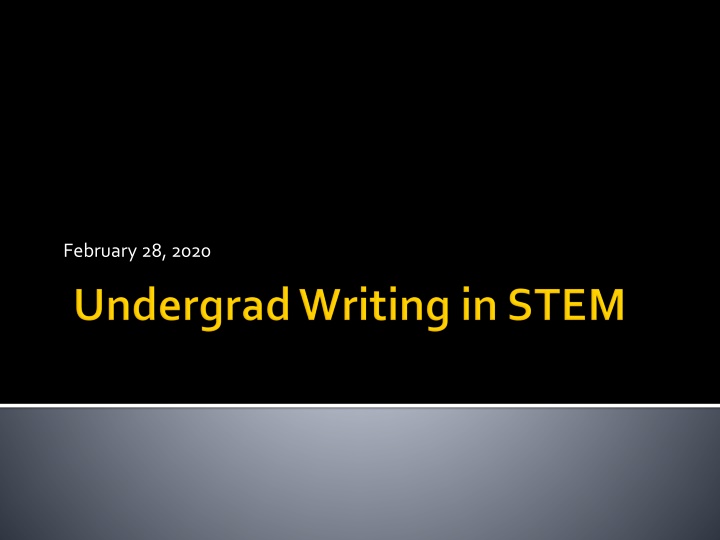
Incorporating Genre Awareness and Drafting into Writing Assignments
This guide emphasizes the importance of genre awareness, drafting, and revision in writing assignments. It discusses how to align learning objectives with genre choices, foster community through peer review, and scaffold assignments to enhance student engagement and learning outcomes.
Download Presentation

Please find below an Image/Link to download the presentation.
The content on the website is provided AS IS for your information and personal use only. It may not be sold, licensed, or shared on other websites without obtaining consent from the author. If you encounter any issues during the download, it is possible that the publisher has removed the file from their server.
You are allowed to download the files provided on this website for personal or commercial use, subject to the condition that they are used lawfully. All files are the property of their respective owners.
The content on the website is provided AS IS for your information and personal use only. It may not be sold, licensed, or shared on other websites without obtaining consent from the author.
E N D
Presentation Transcript
To foreground purpose & genre in assignment design To build writing-as-process into assignments To build community
Describe for students the values you believe the document should display. Describe and define the kind of role you expect the students to adopt (i.e., a professional, workplace role? or a laboratory aide writing to reproduce procedures?)
Genre awareness is key to understanding purpose, audience, and situation of writing. Is your assignment a genre typical of schools, or is it aiming to replicate or draw upon professional genres in your discipline (workplace or academic)? How does the purpose influence what genre you choose?
Consider one of your assignments that involves writing and jot down notes about the following: Briefly describe the assignment. What is the purpose of this kind of document? What are students supposed to learn from doing this assignment? (learning objective)
How do your learning objectives and choice of genres align with each other? How do you communicate them to the students?
Build drafting and revision into assignments (even if not turned in or graded). Use peer review, either during or outside of class. Make the revising process part of the assignment (including response to reviewer comments or reflection on how comments were incorporated).
Chunk or scaffold the assignment. Incorporate your values into the assignment. For example, do you value papers that keep you engaged or bring in primary literature? Review the assignment a few times during class and ask for questions. Offer students models and examples of the writing process.
CEE444, Zilles, ~30 students, mostly first year grad/seniors One page essay introducing classmates to a topic area that involves both environmental engineering and microbiology written at the beginning of the semester, written without a background in biology, loosely based on a journal article they choose. Objectives of this essay were to: Give students a reason to care about a required class, by finding some aspect of microbiology that relates to a topic they care about, Help students develop basic skills for finding and reading journal articles, Prepare students for the longer and more technically complex term paper by modeling the writing process and my expectations & grading.
Feedback & Grade Assignment Submission Feedback & Grade Revision Product-oriented: minimal instruction before first submission Some process elements: optional rounds of revision
Stage 2b: Bullet points on microbe s role(s) Good or Not a review, try again None, unless they choose other Stage 2a: Submit citation of review Stage 1: Select topic area Check accuracy Stage 3: Submit citation of journal article Stage 4: Bullet points on article objective s Good, A review, or Needs micro Underst anding & accuracy Submission Feedback & Grade Feedback & Grade Revision* * Did not grade stages, but on-time completion was a pre-condition for revision.
Stage 2b: Bullet points on microbe s role(s) Good or Not a review, try again None, unless they choose other Stage 2a: Submit citation of review Stage 1: Select topic area Check accuracy Stage 3: Submit citation of journal article Stage 4: Bullet points on article objectives Good, A review, or Needs micro Understa nding & accuracy Submission Feedback & Grade Feedback & Grade Revision* Process-oriented: modeling steps to learn about a new topic Scaffolding: checking each stage before they begin the next Still allowing optional rounds of revision
Observations from two trials: Response to the stages was quick & caught problems early. Quality of the submissions was higher. Students did fewer rounds of revision. Office hours re-named optional writing labs . More students attended. From the questions they asked, I learned new things about where they were getting stuck. Seemed to help level the playing field for differences in background. Along with returning first submission, passed around a sign-up sheet for 10 min consults. Increased fraction of students discussing with instructor Prompted specific questions Helped clarify written comments and focus their revision efforts
Scaffold the sequence of assignments (let them build on one another). Explicitly write out the connections between the concepts taught and what the assignment entails. Consider the purpose of the specific sequence: What kind of writing is necessary?
Thinking back to your freewrite and the purpose of your assignment, what aspects of today s material do you find most exciting? What are your concerns?
Bring two copies of an assignment youd like to workshop.

